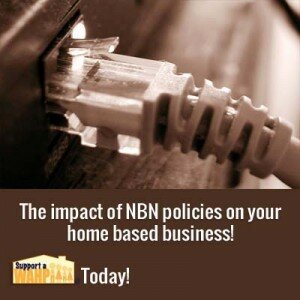 In part one, I explained the difference between the different types of broadband networks being proposed by each political party here in Australia, in the lead up to the Federal election. In this post, I share my opinion on which NBN plan is better for micro and home based businesses (approx 82.4% of all businesses in Australia)
In part one, I explained the difference between the different types of broadband networks being proposed by each political party here in Australia, in the lead up to the Federal election. In this post, I share my opinion on which NBN plan is better for micro and home based businesses (approx 82.4% of all businesses in Australia)
It’s not much of a contest really.
There are four major issues with the coalition’s NBN plan.
Firstly, they buy Telstra’s copper network (and this funding is very vague in the opposition plan).
Telstra can’t believe their luck that anyone is stupid enough to buy their ageing rotting copper that has been in the ground for up to 80 years, and has NOT been proactively maintained for the last ten years or so on the basis it’s likely to be replaced. This is a ticking time bomb in maintenance costs which the coalition NBN would have to absorb. The last figures I found showed that proper maintenance of the copper would entail upwards of $1b per year (and rising). This is an ongoing cost which the government NBN just does not have. (and age).
Secondly, the coalition relies on building nodes throughout the suburbs.
These are fridge size cabinets on every street corner which require separate electricity supply, and are likely to be visually unappealing for many (see http://www.smh.com.au/it-pro/government-it/nbn-street-cabinets-hideous-20130411-2hoka.html). The government plan will also require nodes as switching stations; however, these nodes will be small briefcase sized pillars which do not require any power supply or back up battery. In short, the installation and running costs of the coalition nodes are magnitudes higher than the government plan.
The requirement for power to the coalition nodes also decreases the reliability of the network in the case of major catastrophe. In the aforementioned Brisbane floods, it is likely that the Government NBN would have continued to function for the most part, while (and require considerable effort to bring back up).
Thirdly, the coalition NBN is not easily upgradable beyond what is finally delivered.
Copper has reached its technological limit (and is fast degrading in the ground) and you cannot get any further speed down it. Fibre, on the other hand, has the potential to move data at almost the speed of light. Labour’s NBN plan is limited by the equipment at the exchange which can be upgraded beyond 1gb fairly easily, once the technology becomes available. The Coalition’s is limited by copper, which would need to be ripped out and replaced by, you guessed it, Fibre.
Tony Abbott has stated that 25MB is more than sufficient for home use today, and on the whole he is correct. However, there are already applications (high definition on demand video for instance) which would require in the order of 25mb speed. Fast forward 10, 20, or 50 years, and we will be requiring speed well beyond what we currently envisage as required. It’s also worth pointing out that some lucky people on cable or on ADSL2+, who live close to an exchange, can achieve close to 25mb now. For them this plan is a status quo – not a leap forward.
Lastly – the cost.
You might say that this is where the coalition plan has the Government’s beat, and of course, on paper it can look that way. But let’s look at the return on investment. $40b from the Government to install 100mb (upgradeable) to 93% of houses, as opposed to $25b to install 25Mb to those same houses. Simply put, we could say we are getting 2.5mb (upgradeable) per $1b from the government, but only 1mb (none upgradeable) per $1b from the coalition. That makes no economic sense to me, and that’s without taking into account the considerable increased maintenance and running costs for the coalition NBN as discussed above.
Given this is ALL from borrowings anyway (both the government and coalition plan), and we can afford to borrow the money due to the business plan of the approximate seven percent return forecast for the Government’s model (and probably similar for the Coalition), we may as well borrow the money to do it right in the first place, and not shackle future generations with the upgrade costs.
I might point out that the upgrade from FTTN to FTTH/P is not just a case of an extra $15b either. Several billion will have been spent on purchasing and installing the nodes, as well as labour to connect the copper to the nodes – all of that is wasted money if you are just going to upgrade to a FTTH/P plan later anyway!
As an aside you might also want to look at what New Zealand has done/is doing. They started to roll out a Coalition like fibre to the node several years back, and have now realised their mistake. They are now actively engaged in a Fibre to the home rollout fairly identical in scope to what the Government NBN is doing!
As a final point I would like to hone in on something I said earlier. The government is funding this as an asset with an expected rate of return. NBN Co is the new generation’s Telstra. It will fully own the network, however, unlike Telstra, it will not be allowed to sell access to the general public. Instead it will act as a wholesaler to existing ISPs to allow users to pick the plans and company which suits them. There will be a considerable income stream form this, and it’s expected (under Labour’s plan) that the debt held by NBN Co will be paid off and become a positive over approximately 30 years. The only access to government money, as such, is NBN Co using the Government’s AAA rating to get cheaper credit. Presumably the above points would also apply to the coalition NBN. Therefore we need to look at this as building an asset for future generations (much as we did when we built Telecom Australia, and OTC which merged to become Telstra), and not just as a money trap for today.
Conclusion
In this article I have shared some of the basic differences between the two networks and their various limitations, but it is by no means comprehensive. The Opposition plan in particular calls for all sorts of different technologies to be used in different circumstances, but this would just make for noise in a discussion about the basic differences. Home based businesses are dependent on fast and reliable internet connections, and this requirement is only going to grow in the future. In our case, Support A WAHP is run at home but I rarely work at home from my office job because sharing the internet connection with the home business, the kids, and my work requirements means that things slow down to a crawl.
Faster internet connections have moved beyond the 1990’s and 2000’s thinking of being a luxury to now being an absolute necessity. It is a shame that partisan politics have come to dominate the broadband debate (the Opposition could just as easily have accepted the Government’s plan rather than come up with their own inferior version), however that is the world we live in. Come September 14 we will know which vision of Australia’s future is likely to come true.
















